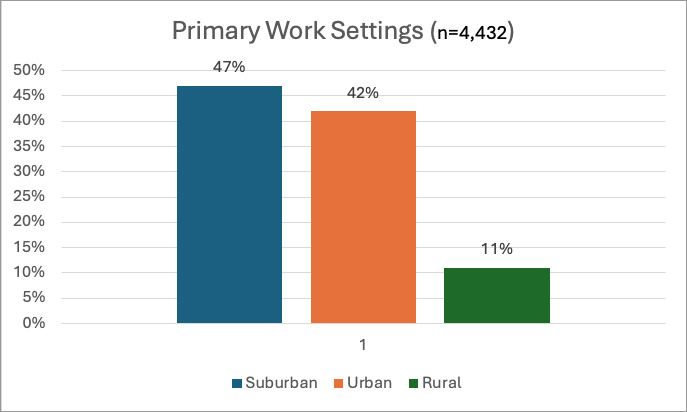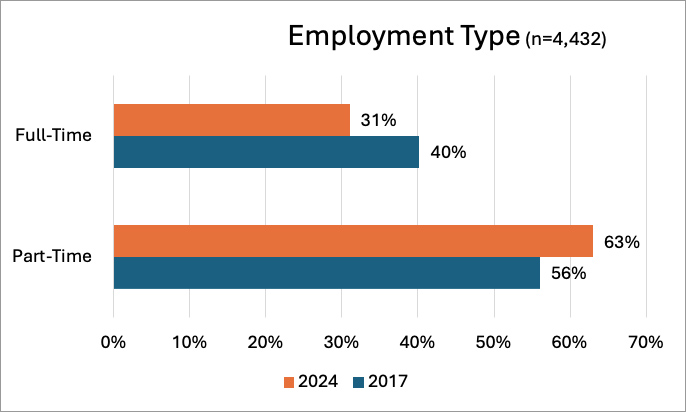Whether you accept it, avoid it or live somewhere in between, insurance coverage has become a defining issue for our profession. Patients increasingly expect to use their benefits, practitioners want to be compensated fairly for their time and expertise, and the system itself remains – at best – fragmented. The encouraging news is that coverage has expanded in meaningful ways. The challenging news is that reimbursement, across the board, remains inadequate.
NCCAOM 2024 Job Analysis: Key Findings and Insights
The National Certification Commission for Acupuncture and Oriental Medicine (NCCAOM) conducted a comprehensive Job Analysis (JA) study in 2023-2024 to ensure the relevance and validity of its entry-level practitioner certification exams. The survey provides a detailed snapshot of the current landscape in acupuncture and herbal medicine profession.
The purpose of the JA survey, the methodology used, and the engagement of key stakeholders were discussed in detail in our first article, published in the March 2025 issue. This article delves deeper into key demographic insights from the survey, highlighting practitioner settings, frequently used techniques, common conditions treated, and the integration of complementary therapies. It also explores evolving practitioner and patient demographics and growing collaboration in health care.
These findings are essential for understanding the profession’s current state, advancing its growth, and guiding future exam updates to ensure practitioners continue delivering high-quality, patient-centered care.
Primary Work Setting
Nearly half (47%) of respondents reported working in a suburban setting, indicating that a significant portion of practitioners serve patients in residential areas that bridge urban and rural communities.
Meanwhile, 42% of respondents practice in urban settings, where there is often greater access to diverse health care services and a higher demand for integrative medicine; and 11% of respondents work in rural settings, highlighting the presence of acupuncture in less densely populated areas, where access to health care services may be more limited.
This distribution reflects the varied landscapes in which acupuncturists practice and underscores the profession’s reach across different community area settings.

Employment Type
The survey revealed that acupuncturists have a diverse range of employment structures, providing insight into the distribution of full-time and part-time practitioners, and highlighting trends in workforce engagement:
- Full-time practitioners (31%): These practitioners dedicate the majority of their professional time to acupuncture and related services, often maintaining steady patient caseloads and structured clinical settings.
- Part-time practitioners (63%): This category includes those balancing acupuncture with other health care roles, academic positions, or personal commitments, which impacts patient volume and availability.
Summary of Trends (2017 JA vs. 2024 JA): Full-time acupuncture work has declined (-9%), while part-time has increased (+7%).
The employment status data helps illustrate practitioner engagement levels in the profession and supports workforce development planning.

Practice Settings
Acupuncturists work in a variety of professional environments, with the majority operating in private practice. The distribution of practice settings provides insights into how practitioners structure their work environments. (Note: The sum of percentages exceeds 100% due to the fact that respondents could select more than one response category.)
- Private practice (70%): These practitioners operate independently, managing their own patient caseloads and administrative responsibilities.
- Group practice/clinic (25%): Acupuncturists working in a group setting collaborate with other health care professionals, benefiting from shared resources and referral networks.
- Hospital-based practice (12%): This segment represents acupuncturists who practice in hospitals that integrate Eastern and Western medicine.
- Academic/teaching clinics (3%): Practitioners in this setting contribute to education and training by working in teaching clinics affiliated with acupuncture programs.
Understanding these settings helps to identify shifts in acupuncture practice models and informs strategies to support practitioners in various environments.
Summary of Trends (2017 JA vs. 2024 JA): More acupuncturists are working in multi-discipline clinics/health care centers (+10%), signaling increased integration into broader health care teams. More acupuncturists are also working in hospital-based settings (+7%).
The increase suggests a growing integration of acupuncture and herbal medicine into mainstream health care. More practitioners working in hospital-based settings indicate that these practices are being recognized and accepted as complementary treatments within conventional medical environments.
Insurance Participation
The survey revealed that nearly half (45%) of practitioners accept insurance payments, highlighting the growing role of acupuncture services within the broader health care reimbursement system. While insurance participation can improve accessibility for patients, many practitioners continue to operate on a cash basis due to administrative challenges and reimbursement rates.
- Accept insurance: 45% of respondents work with various health insurance providers, 18% through veteran’s benefits, 14% through worker’s compensation, 9% through Medicare, and 6% through Medicaid.
- Accept cash payments: The majority of respondents (93%) accept time-of-service payments.
Understanding insurance participation helps identify financial trends within the profession and potential areas for advocacy regarding insurance coverage expansion.
Acupuncture Practitioner Gross Income
Approximately one quarter of respondents (22%) earned $25,000 or less in 2023, 17% earned from $25,001 to $50,000, and 18% from $50,001 to $75,000. Thirteen percent earned from $75,001 to $100,000, 11% from $100,001 to $150,000, and 10% above $150,000. The remainder declined to state.
This distribution underscores both the opportunities and challenges within the acupuncture field, with income potential increasing alongside experience, strategic practice development, and service expansion. This can also be accounted for by an increase in the prevalence of part-time work.
Patient Demographics
The NCCAOM JA survey provides insights into the types of patients who seek acupuncture treatment and how frequently they visit practitioners. These findings help to illustrate trends in patient needs and the demand for acupuncture services.
- Primary patient age range: 98% of respondents see patients who are between 31 and 65 years of age, 77% see patients who are 66 years or older, and 67% see patients who are between 18 and 30 years of age. Over one-third of respondents (35%) see teenagers between the ages of 13 and 17, and 21% see children from birth to 12 years of age.
- Top reasons for visits: Pain management, stress relief, musculoskeletal and orthopedic problems and neurological problems. Pain remains the leading reason patients seek acupuncture, with many also looking for relief from anxiety, sleep disorders, digestive issues, and chronic conditions.
These insights highlight the continued role of acupuncture services in managing chronic conditions and its growing integration into holistic health care practices.
Editor’s Note: Part 2 of this article (June issue) presents clinical findings from the 2024 Job Analysis including health care practitioner referrals, commonly treated conditions, and most frequently used techniques / treatments. The web version of both parts includes charts presenting the data in easy-to-digest format.



